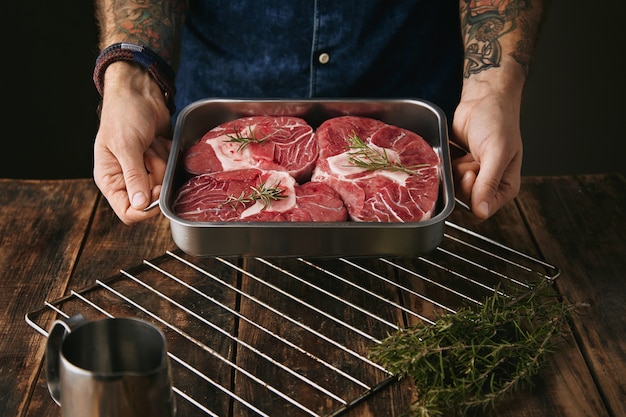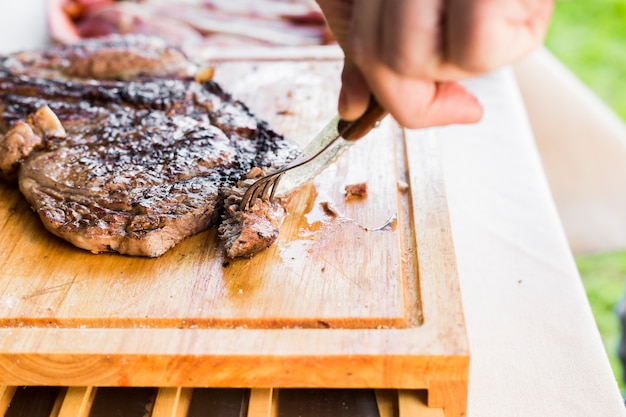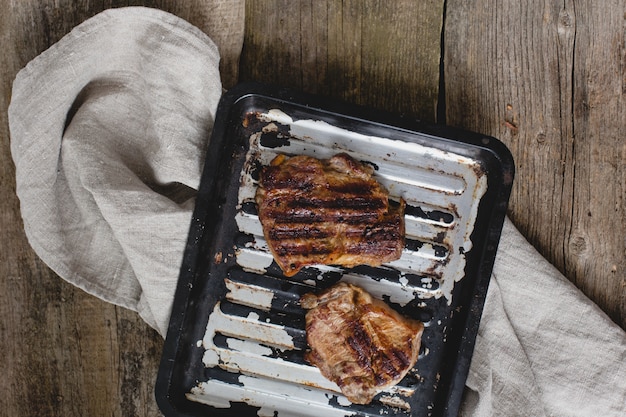There's a reason why prime rib is considered a culinary masterpiece. The rich, flavorful meat, the impressive presentation, and the undeniable satisfaction of carving into a perfectly cooked roast—it's truly a dining experience that elevates any occasion. But, let's be honest, tackling a prime rib can feel a bit intimidating. It's a big piece of meat, with a lot riding on its success.
But I'm here to tell you, my fellow food enthusiasts, that mastering the art of prime rib isn't as daunting as it seems. It's a journey, a process of understanding the key elements and applying a few essential techniques. This isn't just a recipe—it's a comprehensive guide to achieving prime rib perfection, ensuring a juicy, tender roast that will leave everyone speechless.
Part 1: Selecting the perfect prime rib

Before we even think about the oven, we need to choose the star of the show—the prime rib itself. This is a crucial first step. Getting this right sets the stage for success.
Understanding the Cuts: A Prime Rib Primer
The prime rib, or standing rib roast, comes from the rib section of the animal. It's a magnificent cut, ideal for feeding a crowd. But within this magnificent cut, there are different options to consider, each with its own unique characteristics.
- prime rib roast (Ribs 3-7): This is the classic, go-to option, offering a balanced blend of tenderness and flavor. It's usually boneless, making it a breeze to carve.
- Rib Roast with Bone (Ribs 6-12): This option adds a touch of rustic charm and extra flavor, thanks to the bone. It's a bit more challenging to carve, but the added flavor makes it worth the effort.
- standing rib roast (Ribs 6-12): This is the ultimate showstopper—a majestic cut that features the bone intact, with the meat left attached. It's ideal for special occasions, and its presence alone elevates any table.
Marbling: The Key to Juiciness
Now, let's talk about something crucial: marbling. This is the intramuscular fat that runs throughout the meat, adding richness and tenderness. Think of it as the secret ingredient to a juicy, flavorful roast. You want to look for a prime rib with good marbling—visible streaks of white fat interspersed throughout the meat. Aim for a roast with marbling rated “select” or higher. It makes a world of difference!
Part 2: Preparing the Prime Rib: Getting Ready for the Oven

Okay, you've got the perfect prime rib. Now it's time to prep it for its starring role in the oven.
Patting Dry: The First Step to Success
Start by patting the roast dry with paper towels. This removes any excess moisture, ensuring that the surface of the roast browns evenly, leading to a crispy crust.
Seasoning with Finesse: Flavoring the Star
Now comes the fun part—seasoning! I love to use coarse kosher salt for its larger crystals, which distribute more evenly and help to season the meat more thoroughly. Don't be shy with the salt and freshly ground black pepper—they enhance the natural flavors of the meat. And remember, this is just the beginning.
Resting: The Secret to Enhanced Flavor
Once seasoned, let the prime rib rest uncovered in the refrigerator for at least 4 hours, or even better, overnight. This allows the salt to penetrate the meat, seasoning it from the inside out. Before you cook, pat it dry again. This step is crucial for creating that irresistible crispy crust.
Just before popping it into the oven, I like to add a final touch of flavor: a generous sprinkle of fresh herbs like rosemary and thyme. The aromatic herbs add a beautiful layer of complexity to the roast, filling your kitchen with a delightful fragrance.
Part 3: Roasting the Prime Rib: The Essential Techniques

Okay, we're ready for the oven! But before we jump in, let's talk about the best techniques for achieving that perfect roast.
The Reverse-Sear: A Proven method for Tenderness
Over the years, I've tried countless methods, and the reverse-sear has emerged as my absolute favorite. It's a two-step approach that delivers consistently juicy, tender results, and it's surprisingly easy to master. Here's the breakdown:
- Low and Slow: Start by cooking the roast at a low temperature—around 225°F (107°C)—for a longer period. This gentle cooking process allows the meat to cook evenly and slowly, resulting in an incredibly tender and juicy roast. The key here is to be patient and let the heat do its magic.
- High and Fast: Once the internal temperature of the roast reaches about 125°F (52°C) for medium-rare, crank up the oven temperature to 450°F (232°C) and roast for another 15-20 minutes. This final sear creates a beautiful, crispy crust, locking in the juices and adding a wonderful depth of flavor.
Oven Temperature: The Importance of Precision
Maintaining a consistent oven temperature is crucial. It ensures that the meat cooks evenly and avoids overcooking or drying out. I always recommend using an oven thermometer to check the actual temperature. Ovens can fluctuate, so having a thermometer helps you stay in control.
Timing is Everything: The Countdown to Perfection
The roasting time will vary depending on the size and weight of your prime rib. A good rule of thumb is to allow 15-20 minutes per pound for a medium-rare roast. But remember, time is just a guideline. Always rely on a meat thermometer to determine when the roast is cooked to your desired doneness.
For medium-rare, aim for an internal temperature of 130°F (54°C). For medium, aim for 140°F (60°C). And for medium-well, aim for 150°F (66°C). Remember, the roast will continue to cook slightly after it's removed from the oven (carryover cooking), so take it out 5-10 degrees below your desired temperature.
Part 4: Monitoring the Roast: Ensuring Success Every Time
Now for the exciting part—monitoring the roast as it cooks. Patience and a trusty meat thermometer are your best allies in this stage.
The Meat Thermometer: Your Culinary Guide
Don't solely rely on the estimated time. Instead, use a digital meat thermometer to check the internal temperature of the roast. Insert it into the thickest part of the roast, making sure it's not touching any bones.
Resting: The Final Touch
Once your prime rib reaches your desired internal temperature, it's time for a little rest. Cover it loosely with foil and let it rest for 15-20 minutes before carving. This allows the juices to redistribute throughout the meat, resulting in an incredibly tender and flavorful roast.
Part 5: Serving the Prime Rib with Flair: The Grand Finale
You've cooked a magnificent roast. Now, let's present it with the flair it deserves. This is where your culinary artistry shines through.
Carving with Confidence: A Skill for Everyone
Carving a prime rib can seem intimidating, but it's a skill that anyone can learn. Follow these tips, and you'll be a carving pro in no time:
- Use a Sharp Knife: A sharp carving knife makes all the difference. A dull knife will tear the meat, making carving frustrating and the presentation less appealing.
- Slice Against the Grain: To achieve tender, juicy slices, carve against the grain of the meat. This means slicing perpendicular to the muscle fibers.
- Thin Slices: For the most impressive presentation and flavor, aim for thin slices. They cook evenly and melt in your mouth.
- Arrange Beautifully: Once carved, arrange the slices attractively on a platter. A bed of fresh herbs or roasted vegetables adds visual appeal and elevates the dish.
Accompaniments: The Symphony of Flavor
A perfectly cooked prime rib deserves a symphony of flavors to complement its rich taste. Here are some classic pairings that elevate the dining experience:
- Roasted Vegetables: Roasted root vegetables like carrots, potatoes, and parsnips bring sweetness and earthy notes to the table.
- Creamy mashed potatoes: Smooth, creamy mashed potatoes provide a comforting counterpoint to the robust flavor of the prime rib.
- Savory Gravy: A rich and flavorful gravy made from the pan drippings elevates the dish to new heights.
- Light Salad: A crisp, refreshing salad balances the richness of the prime rib and adds a touch of freshness.
- Red Wine: A full-bodied red wine like Cabernet Sauvignon or Merlot complements the prime rib's flavor perfectly.
Part 6: Prime Rib Variations: Beyond the Basics
The classic prime rib is a timeless favorite, but there's a world of culinary possibilities to explore. Here are some variations to spice things up and add your personal touch.
Herb-Crusted Prime Rib: A Burst of Aroma
For a burst of flavor and an aromatic experience, try making an herb crust. Mix chopped fresh herbs like rosemary, thyme, and parsley with olive oil, salt, and pepper. Coat the roast generously with this mixture before roasting. The herb crust will caramelize during cooking, adding a delightful dimension to the meat's flavor.
Garlic-Rosemary Prime Rib: A Taste of Comfort
For a taste that's both comforting and complex, rub the roast with a mixture of minced garlic, fresh rosemary, olive oil, salt, and pepper. Roast as usual, and you'll be rewarded with a flavorful, aromatic roast that's sure to please.
Spiced Rub Prime Rib: Adventure on a Plate
Add a touch of adventure with a spiced rub. Combine your favorite spices like paprika, cumin, chili powder, garlic powder, and onion powder. Rub the roast with the spice mixture before roasting for a unique flavor profile. Experiment with different spice combinations to find your perfect blend.
Part 7: Leftovers: Putting Your Prime Rib to Good Use
Let's face it—a prime rib is so delicious that you might be tempted to go back for seconds, thirds, and even fourths. But inevitably, you'll have leftovers. Don't let them go to waste! Turn those leftovers into delicious meals.
Prime Rib Sandwiches: A Flavorful Treat
Slice the leftover prime rib thinly and pile it high on crusty rolls for a satisfying and flavorful sandwich. Add your favorite condiments like horseradish sauce, mustard, or mayonnaise. You can even create a prime rib panini with melted cheese and roasted vegetables for a more decadent treat.
Prime Rib Hash: A Hearty and Flavorful Meal
Dice the leftover prime rib and saute it with diced potatoes, onions, and your favorite spices for a hearty and flavorful hash. Serve it with a fried egg or a dollop of sour cream for an extra touch of indulgence. It's a perfect way to enjoy prime rib for breakfast or brunch.
Prime Rib Soup: Comforting and Delicious
Transform your leftover prime rib into a comforting and satisfying soup. Simmer the meat with vegetables, broth, and your favorite herbs for a delicious and hearty meal.
Part 8: FAQs: Answering Your Prime Rib Questions
Here are some frequently asked questions about prime rib, along with helpful answers to guide you on your culinary journey:
Q: What if my prime rib is too large for my oven?
A: If your oven is too small to accommodate the whole roast, consider separating it into two portions. Roast each portion separately, ensuring each piece is evenly cooked. You can even use a roasting pan with a rack to elevate the meat, ensuring even browning.
Q: Can I cook prime rib in a slow cooker?
A: While you can technically cook prime rib in a slow cooker, it's not the ideal method. The slow cooker doesn't offer the same browning capabilities as an oven, and the roast may end up dry and tough. For optimal results, stick with oven roasting.
Q: How long can I store prime rib in the refrigerator?
A: Cooked prime rib can be stored in the refrigerator for up to 3-4 days. Make sure to wrap it tightly in plastic wrap or aluminum foil to prevent drying.
Q: Can I freeze leftover prime rib?
A: Yes, you can freeze cooked prime rib for up to 3 months. Freeze it in an airtight container or wrap it tightly in freezer-safe plastic wrap or aluminum foil. When ready to use, thaw it in the refrigerator overnight.
Q: What are some other tips for cooking prime rib?
A: Here are some additional tips to keep in mind:
- Use a Meat Thermometer: A meat thermometer is essential for ensuring the roast is cooked to your desired doneness. It takes the guesswork out of cooking, ensuring you achieve perfect results every time.
- Don't Overcook: Prime rib is best cooked to medium-rare or medium. Overcooking will result in a dry and tough roast. Remember, the goal is tenderness and juiciness.
- Let the Roast Rest: Allow the roast to rest for 15-20 minutes before carving. This allows the juices to redistribute throughout the meat, resulting in a more tender and flavorful roast.
- Use High-Quality Ingredients: The quality of the prime rib makes a difference in the flavor and tenderness of the roast. Investing in a high-quality cut from a reputable butcher or supermarket is worth the investment.
Cooking a prime rib is an exciting culinary adventure. By following these steps and experimenting with different flavors and variations, you can elevate your dining experience to new heights. So, gather your ingredients, fire up the oven, and prepare to impress your loved ones with a prime rib that will leave them speechless. Happy cooking!
Everyone is watching

How to Cook Frozen Lobster Tails Perfectly: A Step-by-Step Guide
RecipesLobster. Just the word conjures up images of lavish meals, special occasions, and a taste of luxury. But let's...

Pigs in a Blanket Cooking Time: How Long to Bake for Perfect Results
RecipesAh, pigs in a blanket. Just the name conjures up images of those delightful little parcels of crispy pastry en...

Pork Fillet Cooking Time: How Long to Cook It Perfectly
RecipesPork fillet, or tenderloin as it's sometimes called, is a real favourite in our house. It's so versatile, and...

The Ultimate Guide to Cooking Delicious Frankfurters
RecipesLet's face it, we all love a good frankfurter. It's a classic, simple, and always satisfying. But let's be rea...

Wolf Meat Recipes: A Guide to Cooking Wild Game
RecipesLet's be honest, you don't see wolf meat at your local butcher shop every day. It's a bit of a wild card, but ...
